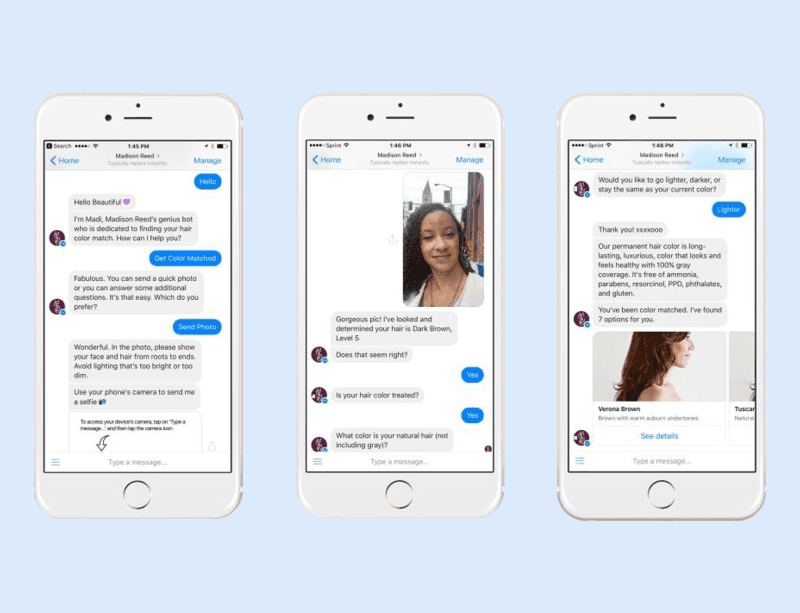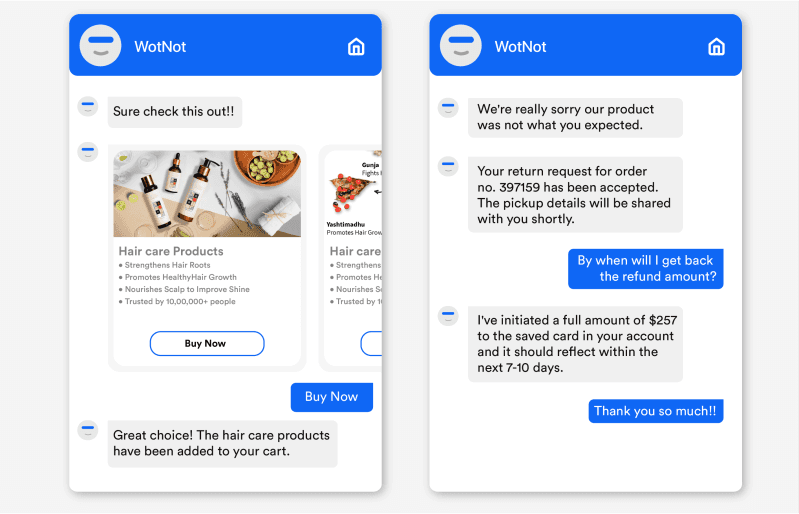Chatbot /
4 Min read
8 Essential Chatbot Scripts for an E-commerce Website
April 7, 2022

Hardik Makadia
CEO, WotNot
Precisely why the E-commerce chatbot script matters- to make the chatbots more conversational, personalized, and empathetic. A good chatbot script could save your customer agents valuable time, reduce operational costs and give you scalable results.
Don't take just our word for it, have a look at some stunning stats-
82% of consumers say that getting instant responses is essential when contacting brands.
Chatbots will be responsible for cost savings of over $8 billion per annum by 2022.
The adoption of chatbots will assist consumers and businesses to save over 2.5 billion customer service hours by 2023.
Chatbots help 55% of companies generate high-quality leads.
Chatbots increase website conversion rate by 33%.
What is a Chatbot Script?
A chatbot script is an outline determining the conversational flow between a user and a chatbot based on user intent, tone, context, and keywords. A well-formulated script ensures that the bot is personalized and can answer the questions promptly and correctly.
To help you get started building an E-commerce chatbot, here are 8 essential tips for writing an effective chatbot script
1. Scripts for Greeting New Visitors
The visitors that visit your page either already know your product or are keen on knowing it.
Why is a chatbot greeting script important, though?
The first thing visitors will see when they land on your page is your chatbot’s welcome message. Hence it is important that you draft the message with the utmost consideration for keywords and tones so as to convey your brand’s personality.
A greeting script should be short and concise such that it welcomes the user and makes them feel valued. It should be conversational and must include links to your blogs or products to carry forward the conversation without human intervention. Better bot experiences with more engaged audiences can generate response rates as high as 80-90%.
Another essential aspect of a greeting script is staying transparent and introducing your bot to your audience. Here’s an excellent welcome chatbot script example-

2. Scripts for Follow-ups
Online shoppers in the US are expected to reach 291.20 million by 2025. To make sure your sales are not thrown under the digital bus, it is important to strategically lure the users to trigger their desire and motivate them to purchase.
Follow-up chatbot scripts are the holy grail here. They are used to identify user pain points and address them, including but not limited to highlighting the product features, offering promotional discounts and free shipping, sending reminders, and showcasing positive feedback from the existing users. The underlying idea is to build an aura around the user’s mind about the product and motivate them to purchase.
Furthermore, since chatbots can analyze buyers’ shopping behavior and patterns, drafting a follow-up script based on the findings would be a wise decision.

3. Scripts to Prevent Cart Abandonment
While the majority of online shoppers complete their transactions, there are some who navigate away before checking out their cart. According to statistics, the average cart abandonment rate on E-commerce portals in the US is as high as a whopping 69.82%. Users might leave the cart filled due to several reasons, including higher pricing, missing information, end-minute new information, etc.
These numbers suggest a considerable revenue loss to the business. E-commerce chatbot scripts can help!
Writing the script to remind the user that the cart has items pending for purchase and offering irresistible offers like huge discounts or free shipping as an incentive is one of the ways to stimulate sales. Secondly, to vacate the abandoned cart, the chatbot script should also engage with the user as much as possible.
Take the following chatbot script example:
Paul logs into his account on an E-commerce portal, add a belt and a wallet to his cart. He goes to the checkout page and finds a shipping fee of $50. When he doesn't click on the pay now button, the brand’s E-commerce chatbot appears.
Chatbot: Hey Paul! You seem to have left items in your cart. Is there something I could help you with to complete the purchase?
Paul: A shipping fee of $50? It wasn’t mentioned earlier anywhere.
Chatbot: The shipping fee is a standard fee charged by the seller on COD orders. You can opt to pay at the time of checkout with reduced shipping of $5. Would you like that?
Paul: Yes, how should I change my payment mode?
Chatbot: I’ve made the edits, and now your prepaid order will cost you a shipping charge of only $5. Enjoy your shopping!
Notice how the E-commerce bot script referred to the user by their first name to create a personal touch. And how it was triggered at the right moment. The tone in the script was light, casual, and friendly, thus increasing Paul’s chances to continue the purchase.
4. Script for Customer Support
Customer Support is a common denominator amongst all industries. There is always the scope to automate the process, so having a customer support chatbot seems like a wise option irrespective of whatever industry you're in.
With AI chatbots prevalent everywhere and in reach of every user, far-reached customer support could be provided by incorporating good, user-friendly scripts. This way, the users can seek details about the products and get answers to FAQs.
A customer support E-commerce chatbot script should be personalized to deliver the best conversational experiences. Secondly, the bot script must contain industry jargon and terminology- as it would build credibility for your chatbot. And lastly, keep the language as natural and fluid as possible and put some humor in your script so that the user gets a natural human touch. 58% of users say chatbots have positively changed their customer service expectations.

5. Scripts for Promotions
Approximately 40% of people of all ages prefer to use chatbots when shopping online. And an E-commerce promotional campaign is a good way to acquaint the users with a brand’s products. Chatbot interactions could be leveraged to ask users to subscribe, share their contact information or make purchases.
The users might share their contact information, for which case an E-commerce chatbot script should be designed to attract them to complete the purchase. It should include key details and USPs of the product, a FOMO (fear of missing out) factor. And in-app notifications (mentioned below) will make users more likely to buy the product.
“Don’t forget to buy the best (product name) at a 20% discount.”
or
“Only 3 days left till it ends.”
Remember to include a reasonable time in-between the messages to avoid spam.
6. Scripts for Cross-Selling
You don’t want your customers to purchase just one time, do you?
Therefore your E-commerce chatbot must keep the customers informed and engaged even after making their purchase. Chatbots steer conversations and result in demand generation.
The trick is to do it strategically via implementing a user-friendly and personalized script. Are you worried it might offend the customers? Well, more than 70% of customers are interested in hearing from retailers after purchasing, especially if they provide personalized content.
Let's take the following chatbot example of an online custom clothing and accessory store. Notice how the chatbot script performs cross-selling by engaging the customer who has purchased a tunic.
Day 1: Hey There! It is a bright sunny day! Don't forget to wear your blue daisy tunic today.
Day 2: The color and print of the tunic are perfect for a sunny day. Oh, and you can wear it at an evening soiree too. It’s a perfect dress, isn't it!
Day 3: How about you accentuate your look with some cool summery sunglasses and a chic handbag?
7. Scripts for Order Placements and Returns
To make the whole shopping experience easier, you can enable users to buy products directly from your chatbot widget. The E-commerce bot script could be designed to provide product possibilities and the price. Once the user selects the product, he should be able to order directly from the bot.

Secondly, implementing a chatbot for returning or exchanging the product also simplifies the process and enhances the user experience. The E-commerce chatbot script should allow users to return or exchange in a hassle-free manner, interact directly with the chatbot and receive status updates in simple text format.
8. Scripts for Customer Feedback
Getting the hang of how customers feel and view your products, services, and support is an invaluable asset for a business.
So, how do you collect customer feedback?
Forms over email?
Well, they have a 10% open rate and a less than 5% completion rate in the best of cases.
Can AI-written scripts help?
A. 100% yes.
Being conversational in nature, there is a good chance of customer interaction. The rule of thumb is to keep it simple. If answering the survey requires time and effort, customers might bounce off. The script should have options to the questions asked in the survey so that the customers don't have to type anything.
Further, including GIFs, images, and color tones in the script will keep the customers more engaged, resulting in a successful survey.
Takeaway
Planning various chatbot scenarios and encompassing essential E-commerce chatbot scripts is essential for a good customer experience and sales boost. You need to trace customers’ buying patterns, identify their pain points, and then leverage them to create customized and personalized scripts.
If you’re wondering how to write a bot script, you don't need coding. You can use the pre-designed chatbot templates or build your own message sequence.
Should you have some questions about how to write a bot script, reach out to us- we’re here to help!
ABOUT AUTHOR
Hardik Makadia
CEO, WotNot
His leadership, pioneering vision, and relentless drive to innovate and disrupt has made WotNot a major player in the industry.



